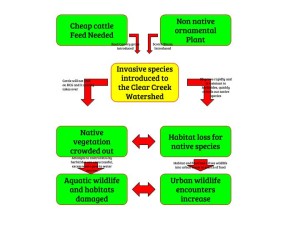Research and describe a topic related to biodiversity affecting a location in your home state, preferably one on close proximity to where you live. Attach a system diagram illustrating the inter-connectivity of the some of the components in your chosen location. Cite any sources used.
Reed Canary grass. Scotch bloom. In Kitsap county, and most of western Washington, these two plants have nearly become household names. Both are non native species that were introduced into the region in hopes to improve habitat for livestock or garden aesthetics. Reed Canary grass was first introduced by farmers in the Clear Creek valley who were looking for a cheap, easy to grow food source for livestock. The problem with reed canary grass was that the livestock would not eat it. It quickly took over native vegetation and crowded out nearly all other grasses and native species. This is still a large problem along clear creek and throughout the valley. It is resistant to herbicides and because of its close proximity to clear creek and its watershed, most can not be sprayed regardless. Manual removal is very labor intensive and costly. Recent attempts to kill off the reed canary grass by covering it with a thick layer of mulch has been shown to be only marginally effective. Scotch bloom is another difficult non native species in my area. First introduced as a garden ornamental, it quickly escaped gardens and established a strong foothold across the region. Scotch Bloom reproduces and spreads quickly, choking out native vegetation, including smaller trees and undergrowth. It also has no known consumers, at least not native to this area. Its pollen is very irritating to most people, especially those with seasonal allergies. Like canary reed grass, it is also very resistant to herbicides and must be removed by hand. Manual removal is very difficult and costly as they are deep rooted and grow several feet tall.
These two non native invasive species have caused a significant amount of native habitat loss in Kitsap county, with reed canary grass being especially prevalent throughout the clear creek watershed. It is currently unknown as to the full extent and range of losses attributed to these plants, but the effects of local wildlife are more easily noticed. As typical forage areas for wildlife are taken over by these invasives, more wildlife are seen foraging closer and actually in town. While having black tail deer and rabbit in your yard may seem innocent enough (not taking eating your plants into consideration), their predators, which follow them in, are causing concern for many residents. Over the last several years, black bear, coyote and cougar sightings inside city limits have grown significantly. As their typical food sources move closer to town, they too, will move closer to town. It is always a little shocking to see the results of tampering with an ecosystem. By adding a new species, just as much damage can be done as if you took a species away. The biodiversity can be radically changed, sometimes irreversibly.


Ben,
The subject of invasive, non-native species has interested me ever since my five-year war with Japanese Knotroot. I think I won. No! Wait! It’s back!
Seriously, yours is an excellent description of a problem which can have enormous, unintended consequences. It can occur in plant life as you mention or with wildlife as well. Your analysis of the effects on other life forms and the difficulties of removing these invasive species is ‘spot on” as are your examples of the chain-reaction effects which occur. Good work!
Mike Evangelista
You can read my post at: https://wp.me/p3RCAy-eIV I took a very different approach to this assignment but you might find it interesting.
PS. Your chart is very good! Do you tutor? (Just kidding!)
Hey Ben! Your blog caught my attention cause I was interested by the types of invasive species you used. I like the chart that you made. It really showed how what you wrote impacted everything and it all flowed together. It’s amazing how these species impacted your hometown. It is also interesting how these species were introduced by farmers. What they thought originally would help them out ended up hurting the ecosystem in the long run.
Great Job!
Here’s my blog if you want to check it out. I talked about HIPPO and how it applied to my hometown: http://geog030.dutton.psu.edu/2016/04/13/module-10-hippo/